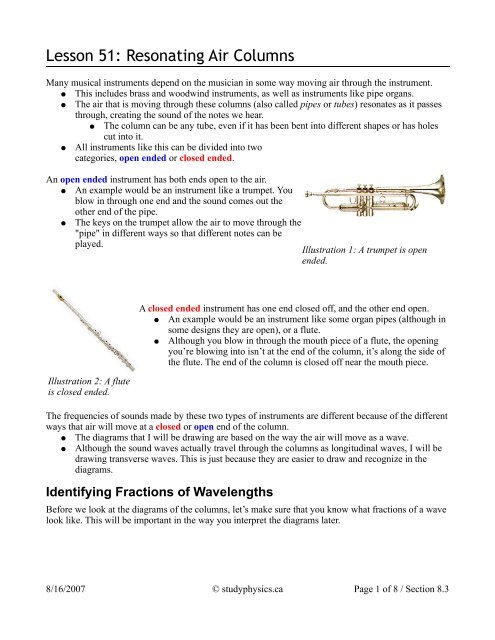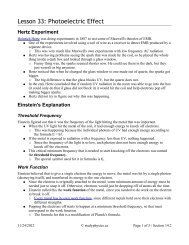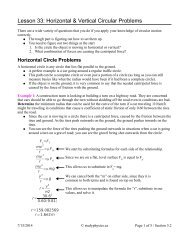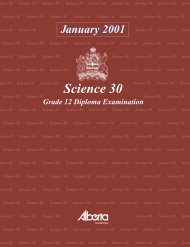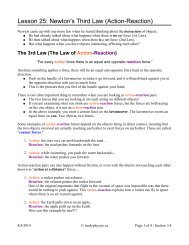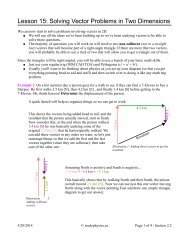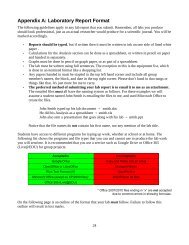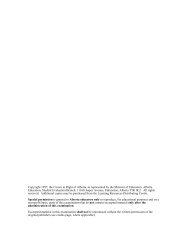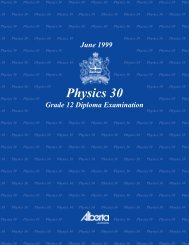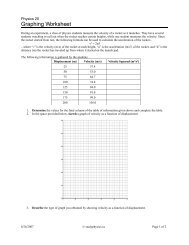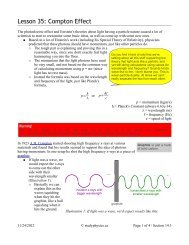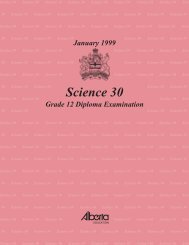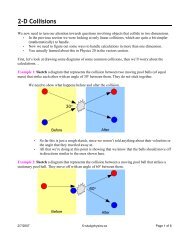Lesson 51: Resonating Air Columns
Lesson 51: Resonating Air Columns
Lesson 51: Resonating Air Columns
- No tags were found...
Create successful ePaper yourself
Turn your PDF publications into a flip-book with our unique Google optimized e-Paper software.
<strong>Lesson</strong> <strong>51</strong>: <strong>Resonating</strong> <strong>Air</strong> <strong>Columns</strong>Many musical instruments depend on the musician in some way moving air through the instrument.● This includes brass and woodwind instruments, as well as instruments like pipe organs.● The air that is moving through these columns (also called pipes or tubes) resonates as it passesthrough, creating the sound of the notes we hear.● The column can be any tube, even if it has been bent into different shapes or has holescut into it.● All instruments like this can be divided into twocategories, open ended or closed ended.An open ended instrument has both ends open to the air.● An example would be an instrument like a trumpet. Youblow in through one end and the sound comes out theother end of the pipe.●The keys on the trumpet allow the air to move through the"pipe" in different ways so that different notes can beplayed.Illustration 1: A trumpet is openended.Illustration 2: A fluteis closed ended.A closed ended instrument has one end closed off, and the other end open.● An example would be an instrument like some organ pipes (although insome designs they are open), or a flute.● Although you blow in through the mouth piece of a flute, the openingyou’re blowing into isn’t at the end of the column, it’s along the side ofthe flute. The end of the column is closed off near the mouth piece.The frequencies of sounds made by these two types of instruments are different because of the differentways that air will move at a closed or open end of the column.● The diagrams that I will be drawing are based on the way the air will move as a wave.● Although the sound waves actually travel through the columns as longitudinal waves, I will bedrawing transverse waves. This is just because they are easier to draw and recognize in thediagrams.Identifying Fractions of WavelengthsBefore we look at the diagrams of the columns, let’s make sure that you know what fractions of a wavelook like. This will be important in the way you interpret the diagrams later.8/16/2007 © studyphysics.ca Page 1 of 8 / Section 8.3
Illustration 3: One wavelength (λ).Illustration 4: Three quarters of a wavelength (3/4 λ)Illustration 5: One half of a wavelength (1/2 λ).8/16/2007 © studyphysics.ca Page 2 of 8 / Section 8.3
Illustration 6: One quarter of a wavelength (1/4 λ).These wave fractions might appear upside down, flipped over, turned around, etc. in the diagrams youwill see, but they will still represent the same portions of a wave.When we are talking about the sounds that columns can make, what we are really concerned with ishow much of the wave we can fit into the column.● Different amounts of a wavelength in a column will result in a different frequency being heard.● Because these are the frequencies of the waves that will naturally resonate in the columns, wecall them the resonant frequencies.● In music, you might have heard these referred to as harmonics.Although the actual length of the column remains the same, different notes are played.● If you have ever played a wind instrument, you know that with the same keys pressed you canplay different notes by controlling how you blow into the instrument… the difference betweenlet’s say a low C and a high C note.● The lowest note you can play (which is also the smallest part of the wave that can fit inside thecolumn) is usually called the fundamental.● If you have no reason to believe otherwise, you should always assume that you aresupposed to do your calculations for the fundamental.● Fitting in more of the wave produces different notes, different harmonics.● Harmonic frequencies will always be multiples of the fundamental.Closed Ended <strong>Columns</strong>Remember that it is actually air that is doing thevibrating as a wave here.● The air at the closed end of the column mustbe a node (not moving), since the air is notfree to move there and must be able to bereflected back.● There must also be an antinode where theopening is, since that is where there ismaximum movement of the air.Illustration 7: Closed ended column,fundamental.8/16/2007 © studyphysics.ca Page 3 of 8 / Section 8.3
Fundamental (First Harmonic)The simplest, smallest wave that I can possibly fit in a closed end column is shown in Illustration 7.● Notice how even though it has been flipped left-to-right and it looks squished and stretched a bitto fit, this is still ¼ of a wavelength.● Since this is the smallest stable piece of a wave I can fit in this column, this is theFundamental, or 1 st Harmonic.Since the length of the tube is the same as the length of the ¼ wavelength, I know that the length of thistube is ¼ of a wavelength… this leads to our first formula:L= 1 4 ●●“L” is the length of the tube in metres. On it’s own this formula really doesn’t help us much.Instead, we have to solve this formula for λ and then combine it with the formula v=fλ to get amore useful formula:L= 1 4 =4Lv=f v=f 4L f = v 4LWhen the wave reaches the closed end it’s going to bereflected as an inverted wave (going from air towhatever the column is made of is a pretty big changeso this is what we would expect. It would look likeIllustration 8.● This does not change the length of the wave inour formula, since we are only seeing thereflection of the wave that already exists in thecolumn.Third Harmonicf = frequency of sound (Hz)v = velocity of sound in air (m/s)L = length of tube (m)Illustration 8: Fundamental for a closed tube,showing reflection.What does the next harmonic look like? Well, for starters it's the 3 rd Harmonic.● I know this name might seem a little confusing, but because of the actual notes produced andthe way the waves fit in, musicians refer to the next step up in a closed end column instrumentas the 3 rd harmonic… there is no such thing as a 2 nd harmonic for closed end columns.● In fact, all of the harmonics in closed end columns are going to be odd numbers.8/16/2007 © studyphysics.ca Page 4 of 8 / Section 8.3
Open End columnsFirst HarmonicI know you’re probably thinking that there couldn’tpossibly be any more stuff to learn about this, but westill have to do open end columns. Thankfully, they’renot that hard, and if you got the basics for closedcolumns it should go pretty fast for you.● The fundamental (first harmonic) for an openend column needs to be an antinode at both●ends, since the air can move at both ends.● That’s why the smallest wave we can fitin is shown in Illustration 12.Illustration 12: Fundamental for an open endcolumn.● This looks different than the ½wavelength that I showed you in Illustration 5, but it is still half of a full wavelength.That means the length of the tube and frequency formula are…L= 1 2 f = v2L● The whole thing after it reflects at the other end looks like Illustration 13.Second HarmonicThe next note we can play is the 2 nd harmonic.Illustration 13: Fundamental for an opencolumn, showing reflection.●●●Yep, open end columns have a 2 nd harmonic…open end columns can have any numberharmonic they want, odd or even.Again, it kind of looks weird, but trace it outand you’ll see that there is exactly onewavelength here.The length and frequency formulas are…Illustration 14: Second Harmonic of an openend column.8/16/2007 © studyphysics.ca Page 6 of 8 / Section 8.3
L= 2 2 f = 2v2LI know that 2 over 2 equals 1, so it isn'treally necessary, but I've left it in so youcan see the pattern in these formulas.Third HarmonicI bet you can guess what the formulas for the third harmonic looks like...●The pattern is still continuing...●●SummaryIllustration 15: Open end column secondharmonic, showing reflection.L= 3 2 f = 3v2LThe number on top can be any even or odd number, the number of the harmonic.The bottom number is always 2 for open ended columns.Harmonic Closed End Column Open End ColumnFundamental (1 st Harmonic) L= 1 4 f = v4LL= 1 2 f = v2L2 nd Harmonic L= 2 2 f = 2v2L3 rd Harmonic L= 3 4 f = 3v4LL= 3 2 f = 3v2L4 th Harmonic L= 4 2 f = 4v2L5 th Harmonic L= 5 4 f = 5v4LL= 5 2 f = 5v2L* The table could continue, although in real life there arepractical limits on how high a harmonic a person canactually play on an instrument.8/16/2007 © studyphysics.ca Page 7 of 8 / Section 8.3
Example 1: An open ended organ column is 3.6m long.a) Determine the wavelength of the fundamental played by this column.b) Determine the frequency of this note if the speed of sound is 346m/s. (Calculate it using theformulas you’ve just learned, although if you wanted you could use v = f λ)c) Determine the note that could be played at the third harmonic on this column.d) If we made the column longer, explain what would happen to the fundamental note… would itbe higher or lower frequency?a)L= 1 2 =2L=23.6=7.2mb)f = v 2Lf = 34623.6f =48Hzc) Notice that in the formula the third harmonic is three times bigger than the firstharmonic. Since you have already calculated the first harmonic, you could just multiplythat answer by 3 if you wanted to. Instead, we'll show the entire calculation here, just tomake sure.f = 3v2Lf = 334623.6f =144 Hz=1.4e2 Hzd) If we made the column longer, the wavelength would be bigger (just look at theformula in part (a) of this example), and since wavelength and frequency are inverselyrelated, that means the frequency would be smaller.8/16/2007 © studyphysics.ca Page 8 of 8 / Section 8.3


